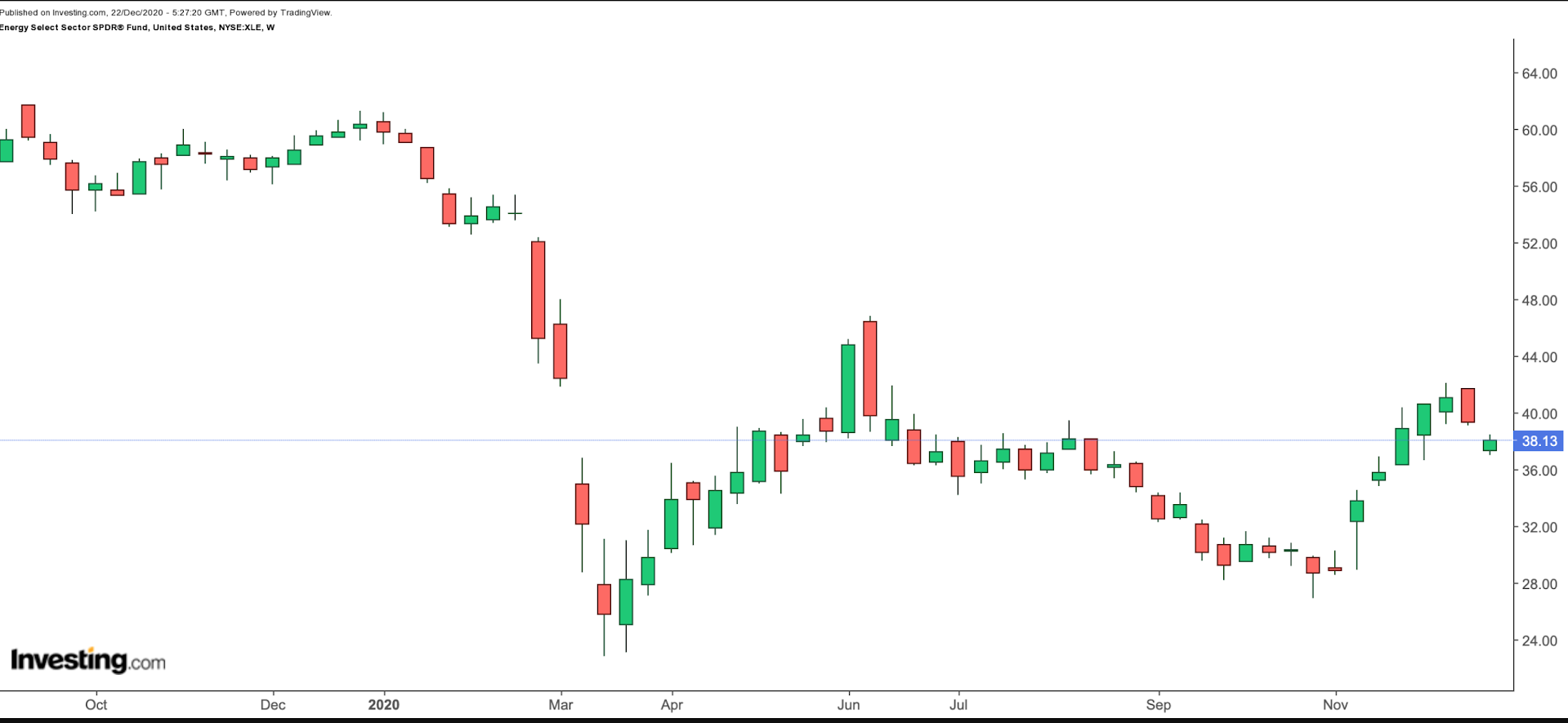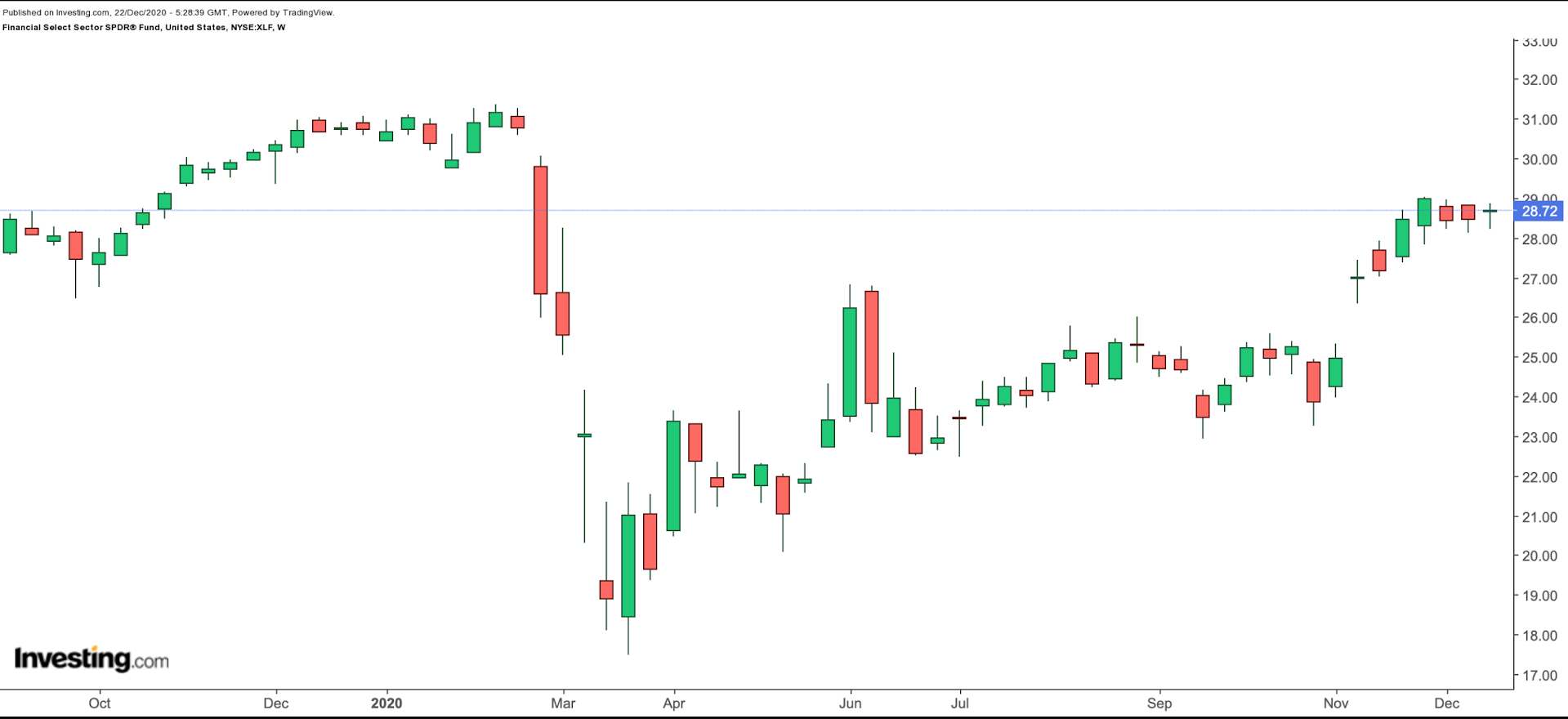Investing in any of the S&P 500 index’s 11 sectors could help diversify long-term retail portfolios.
In this three-part series, we are taking a closer look at each sector and appropriate ETFs to gain exposure. Yesterday's post addressed}} three sectors: Communication Services, Consumer Staples and Consumer Discretionary. We'll be publishing part three on Wednesday.
Below we'll discuss ETFs to consider for four additional sectors: Energy, Financials, Health Care and Industrials.
4. Energy
The Energy Select Sector SPDR Fund (NYSE:XLE) provides access to firms in oil and gas as well as energy equipment and services industries.
XLE, which has 25 holdings, tracks the performance of the Energy Select Sector Index. The fund started trading in December 1998 and currently has more than $13.9 billion under management.
Exxon Mobil (NYSE:XOM), Chevron (NYSE:CVX), ConocoPhillips (NYSE:COP), Schlumberger (NYSE:SLB), EOG Resources (NYSE:EOG) and Phillips 66 (NYSE:PSX) lead the firms in the fund. XOM and CVX shares make up close to 44% of the XLE and the top 10 names comprise 76.21% of net assets.
2020 has been a difficult year for the energy sector, as share prices of oil producers have remained under pressure. XLE is down close to 37% year-to-date (YTD). The current price supports a dividend yield of 2.2%. Trailing P/E and P/B ratios are 25.95 and 1.32, respectively.
Those investors who believe the sector may have a comeback in 2021 could also research two other exchange-traded funds: the Vanguard Energy Index Fund ETF Shares (NYSE:VDE) and the Fidelity® MSCI Energy Index ETF (NYSE:FENY).
5. Financials
The Financial Select Sector SPDR® Fund (NYSE:XLF) invests in a range of financial services firms, including banks, insurers, asset managers, brokers and real estate investment trusts (REITs).

XLF, which follows the Financial Select Sector Index, has 65 holdings. Since its inception in December 1998, the fund has grown assets under management to $24 billion.
Among the leadings names in the fund are Berkshire Hathaway (NYSE:BRKa), JPMorgan Chase (NYSE:JPM), Bank of America (NYSE:BAC), Citigroup (NYSE:C), Wells Fargo (NYSE:WFC) and BlackRock (NYSE:BLK). Around 53% of the fund is concentrated on the top 10 stocks.
So far in the year, the fund is down about 7%. Its dividend yield is 2.7%. Trailing P/E and P/B ratios are 17.55 and 1.33, respectively.
Long-term investors who believe banks and other financial institutions will be able to navigate the current economic and low-interest environment could also consider other ETFs, including the Vanguard Financials Index Fund ETF Shares (NYSE:VFH) and the iShares U.S. Financials ETF (NYSE:IYF).
6. Health Care
In 2020, health became one of the most important aspects of life for billions people across the globe. The Health Care Select Sector SPDR® Fund (NYSE:XLV) offers exposure to biopharma and life sciences firms as well as those that provide healthcare equipment and supplies. It started trading in December 1998 and has $25.3 billion under management.

XLV, which holds 63 stocks, tracks the Health Care Select Sector Index.
More than 50% of the fund's assets are concentrated in the top 10 names, which include Johnson & Johnson (NYSE:JNJ), UnitedHealth (NYSE:UNH), Pfizer (NYSE:PFE), Merck (NYSE:MRK), Abbott Laboratories (NYSE:ABT) and AbbVie (NYSE:ABBV).
YTD, the fund has returned more than 8% and hit a record high of $114.41 on Nov. 9. Its price supports a dividend yield of 1.9%. Trailing P/E and P/B ratios stand at 17.81 and 4.52, respectively.
In addition to XLV, one of the oldest ETFs in the health-care segment, investors may want to put the following funds on their radar: the Vanguard Health Care Index Fund ETF Shares (NYSE:VHT) and the iShares Nasdaq Biotechnology ETF (NASDAQ:IBB).
7. Industrials
The Industrial Select Sector SPDR Fund (NYSE:XLI) invests in shares of companies that mainly manufacture or distribute capital goods. They include businesses that focus on aerospace and defense, construction, engineering, electrical equipment, transportation infrastructure and industrial machinery.

XLI, which tracks the performance of the Industrial Select Sector Index, has 73 holdings.
Leading names include technology and manufacturing company Honeywell International (NYSE:HON), railroad transportation firm Union Pacific (NYSE:UNP), global shipping and logistics company United Parcel Service (NYSE:UPS), aerospace and defense giant Boeing (NYSE:BA), aerospace and defense manufacturer Raytheon (NYSE:RTN) Technologies (NYSE:RTX) and diversified manufacturer 3M (NYSE:MMM). More than 40% of the fund is in the top 10 businesses.
Since the start of the year, XLI has added around 7% and the dividend yield is 2.1%. The fund hit an all-time high of $90.15 Nov. 24. Trailing P/E and P/B ratios are 24.6 and 4.66, respectively.
Those investors who believe the sector could benefit further from the vaccine rollout and potential economic recovery in the coming quarters may want to do due diligence on XLI as well as two other funds in the sector. They are the Vanguard Industrials Index Fund ETF Shares (NYSE:VIS) and the iShares U.S. Industrials ETF (NYSE:IYJ).
Editor's note: Read part one {{art-200548524||here.
